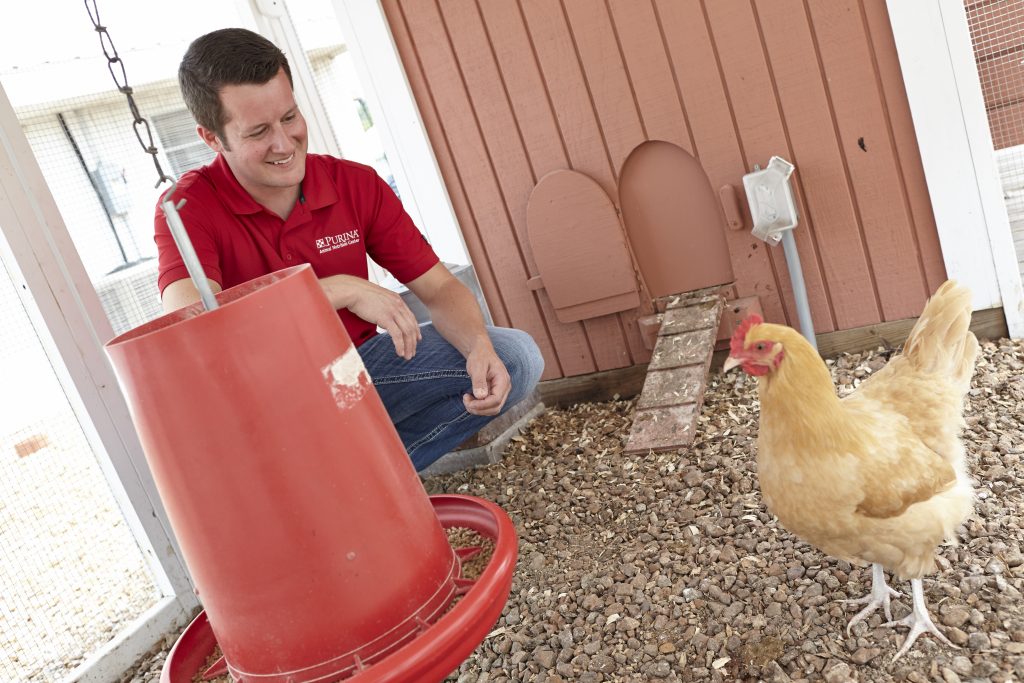
Beyond the feeder: How do chickens digest feed?
By Purina Animal Nutrition
Features Health Layers Backyard chickens Egg production Livestock Production Nutrition Production United States Chickens require 38 different nutrients for optimal health and egg production. One way to provide these nutrients is through a complete layer feed. Purina Animal Nutrition
Chickens require 38 different nutrients for optimal health and egg production. One way to provide these nutrients is through a complete layer feed. Purina Animal NutritionAugust 3, 2017, Shoreview, Minn. – There’s nothing like a complete, balanced layer feed. But what happens after your chickens are finished pecking away at the feeder?
“Few of us consider the events after we bring a bag of chicken feed home; we just know our birds like us to keep the feeder full,” says Patrick Biggs, Ph.D., a flock nutritionist with Purina Animal Nutrition. “Have you ever thought about what happens between when a hen eats at the feeder and when she lays an egg 24 to 26 hours later?”
To help answer this question, Biggs recently discussed bird anatomy with two bloggers: The Chicken Chick, Kathy Shea Mormino, and The Garden Fairy, Julie Harrison. During a tour of the Purina Animal Nutrition Center in Gray Summit, Mo., he explained once a crumble or pellet is consumed by a bird, it travels through a unique pathway for digestion with each ingredient serving a specific purpose.
“Chickens are excellent converters of feed, channeling those nutrients directly into their eggs,” says Biggs. “Laying hens need 38 different nutrients to stay healthy and produce eggs. Think of a complete chicken feed as a casserole – it’s a mixture of ingredients where each part adds up to a perfectly balanced whole. Each ingredient is the digested by the hen, with many of them working together for bird health and egg production.”
Ready to find out where chicken feed goes once eaten? Follow the journey beyond the feeder:
Eating on the go
While chickens need to eat to stay healthy just as people do, a bird’s digestive anatomy is quite different than ours.
“Chickens don’t have teeth and they are a prey animal, so they can’t waste much time chewing,” explains Biggs. “Instead, they swallow food quickly and store it away. The crop, a pouch-like organ meant solely for storage, is the first pit stop feed will encounter.”
Within the crop, very little digestion occurs. Feed will combine with water and some good bacteria to soften food particles before moving through the system. The feed in the crop will be released to the rest of the digestive tract throughout the day.
The chicken stomach
The next stop in the feed journey is the proventriculus, which is equivalent to the human stomach. This is where digestion really begins in the bird. Stomach acid combines with pepsin, a digestive enzyme, to start the breakdown of feed into smaller pieces.
“For birds, feed doesn’t spend much time in the proventriculus,” Biggs says. “Instead, it quickly moves to the gizzard where the real fun begins. The gizzard is the engine of the digestive system – it’s a muscle meant for grinding food particles. Since chickens lack teeth, they need a different method of mechanically digesting food. Historically, this is where grit would play a big role; however, many of today’s complete layer feeds include the necessary nutrients without a need for grit.”
Absorbing the magic
Nutrients are then absorbed through the small intestine and passed into the bloodstream. These absorbed nutrients are used for building feathers, bones, eggs and more. Many of these essential nutrients must be provided through the diet.
“For example, methionine is an essential amino acid, that must be provided through the diet,” explains Biggs. “Like all amino acids, methionine comes from protein sources and is needed at the cellular level to build specific proteins used for feathering, growth, reproduction and egg production.”
This is also where calcium and other minerals are absorbed into the blood stream to be stored for bone strength and shell production.
Building an egg
“In addition to absorbing nutrients to stay healthy, hens also channel feed nutrients directly into their eggs,” says Biggs.
The yolk is formed first. The yolk color comes from fat-soluble pigments, called xanthophylls, which are found in a hen’s diet. Hens may direct marigold extract from the feed to create vibrant orange yolks and omega-3 fatty acids to produce more nutritious eggs.
Next, the shell is formed around the contents of the egg in the shell gland. This is where shell color is created. Most shells start white and then color is added. Breeds like Orpingtons, Rhode Island Reds, Marans, Ameraucanas or Easter Eggers, will apply pigments to transform white eggs to brown, blue or green.
No matter the shell color, calcium is essential at this stage. Calcium travels to the shell gland via the bloodstream. Hens channel calcium first into their eggs and then into their bones. If a hen doesn’t have enough calcium, she will still form the eggshell but her bone strength may suffer which could lead to osteoporosis.
“There are two types of calcium chickens need: fast release and slow release,” Biggs explains. “Fast release calcium is found in most layer feeds and breaks down quickly. This quick release is important for bird health, but can leave a void after hens have eaten and are forming eggs at night.”
“Slow release calcium breaks down over time so hens can channel the calcium when they need it most for shell development,” continues Biggs.
Print this page